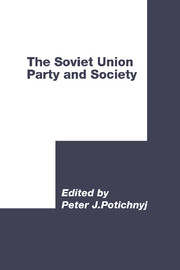Book contents
- Frontmatter
- Contents
- List of figures
- List of tables
- List of contributors
- Foreword by R. C. Elwood
- Preface by P. J. Potichnyj
- Part 1 Party apparat
- Part 2 Socialization and political discourse
- Part 3 Social policy
- 9 Social deprivation under Soviet full employment
- 10 The Soviet social security system: its legal structure and fair hearings process
- 11 Abortion in the Soviet Union: why it is so widely practiced
- 12 Ethnic group divided: social stratification and nationality policy in the Soviet Union
- 13 The party and Russian nationalism in the USSR: from Brezhnev to Gorbachev
- Index
- Publications from the Third World Congress for Soviet and East European Studies
10 - The Soviet social security system: its legal structure and fair hearings process
from Part 3 - Social policy
Published online by Cambridge University Press: 04 August 2010
- Frontmatter
- Contents
- List of figures
- List of tables
- List of contributors
- Foreword by R. C. Elwood
- Preface by P. J. Potichnyj
- Part 1 Party apparat
- Part 2 Socialization and political discourse
- Part 3 Social policy
- 9 Social deprivation under Soviet full employment
- 10 The Soviet social security system: its legal structure and fair hearings process
- 11 Abortion in the Soviet Union: why it is so widely practiced
- 12 Ethnic group divided: social stratification and nationality policy in the Soviet Union
- 13 The party and Russian nationalism in the USSR: from Brezhnev to Gorbachev
- Index
- Publications from the Third World Congress for Soviet and East European Studies
Summary
Introduced by the Soviet government five days after assumption of power, on November 1917, the social security system has undergone many changes, and by now is a huge, complex and expensive undertaking. Throughout its existence, the system has been subject to a flood of normative acts, model acts (for collective farms), decrees, and regulations. Their “fluidity” has not abated, producing ever proliferating statutes – to say nothing of “instructional letters” emanating from the functioning of the system now in effect – all of which adds up to a very complicated and disjointed scenario. Writing in 1984, a Soviet authority complained that “the accumulation of layers of acts during decades, constant additions to and changes in them have led to a situation in which even specialists find it difficult at times to implement social security legislation in practice.”
Concern with administrative “errors” generated by legal complexities and ambiguities, which are either costly for the system or “pinch” the rights of its clientele, has been gaining momentum since 1967 when the question of an independent status for social security law within the Soviet system of jurisprudence was first raised. Discussion has ranged over the “imperative” need for a complete codification of social security laws which has yet to be achieved; for a clear-cut, unified concept of social security which has never been produced, either in law or in scholarship; for a clear demarcation of relations between social security and social insurance; for a definition of pensions as distinct from grants (posobiia); and for an up-dated concept of “old age.”
- Type
- Chapter
- Information
- The Soviet Union: Party and Society , pp. 179 - 200Publisher: Cambridge University PressPrint publication year: 1988

